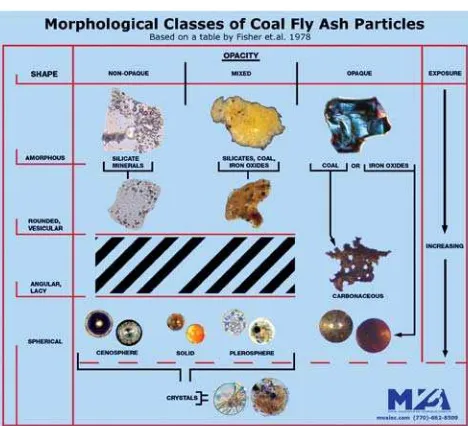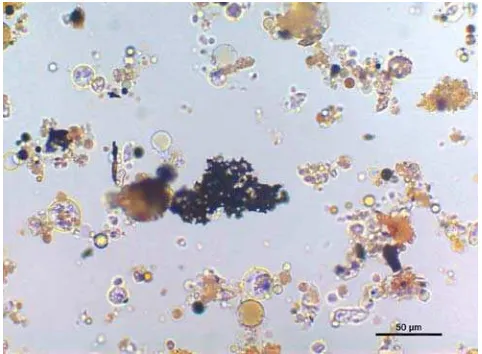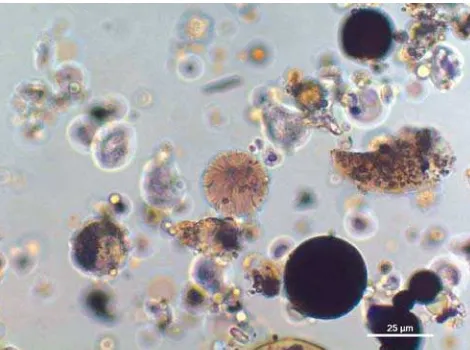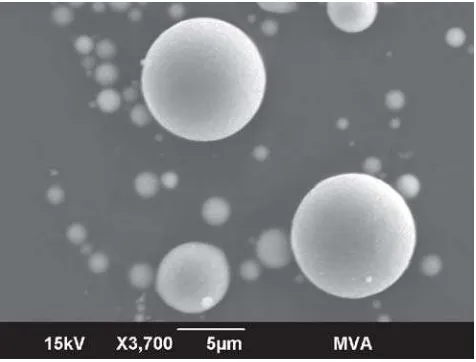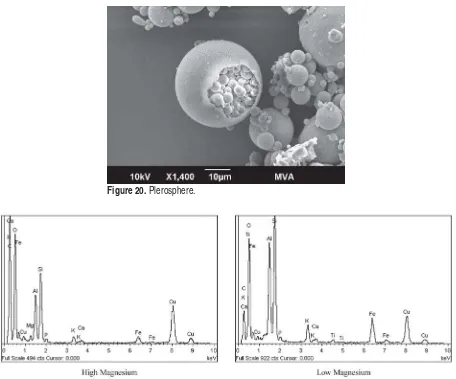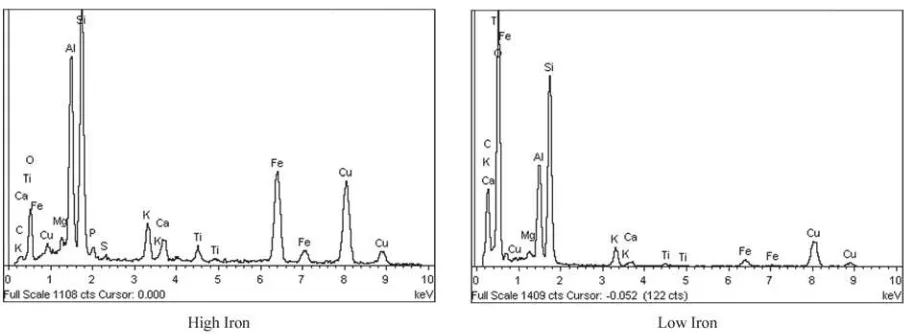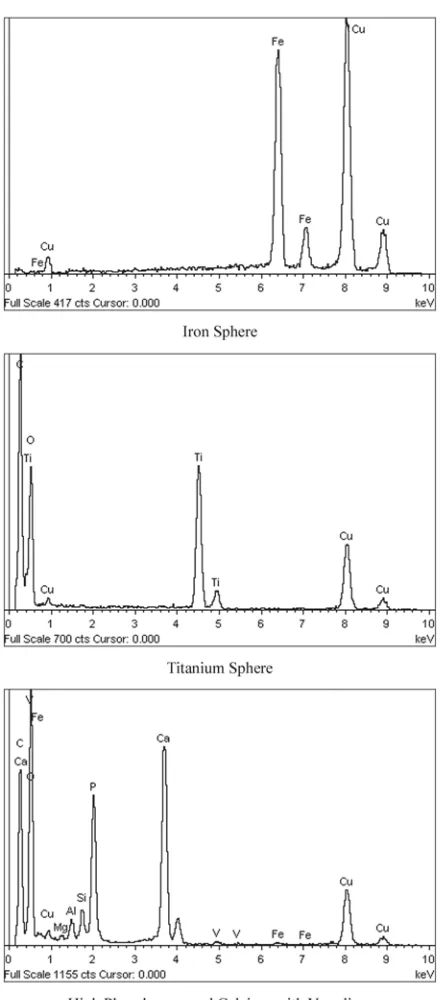Characterization of Coal Ash Including Fly Ash Particles
J.R. Millette1, S. Compton1, W.L. Turner Jr.1, S.M. Hays2, S. Kenoyer2, W.B. Hill1 and P.S. Chepaitis1MVA Scientific Consultants1
Gobbell Hays Partners, Inc.2
KEYWORDS
Coal combustion products (CCPs), cenospheres, energy X-ray dispersive spectrometry (EDS), flue gas desulfurization material (FGD), plerospheres, phase contrast microscopy (PCM), polarized light micros-copy (PLM), scanning electron microsmicros-copy (SEM), transmission electron microscopy (TEM)
ABSTRACT
Particles of coal ash can be distinguished from other dust particles based on optical microscopy ex-amination and electron microscopy analysis. This pa-per provides some background information about coal ash/fly ash and augments the information in the pub-lished literature about the particle characteristics as determined by light and electron microscopy. The au-thors also describe a method for determining the num-ber of fly ash particles per unit area of surface dust.
INTRODUCTION
According to the U.S. Environmental Protection Agency, coal combustion products (CCPs) are the ma-terials produced during the process of burning coal in thermal power plants. CCPs include coal ash (bottom ash and fly ash), boiler slag and flue gas desulfuriza-tion material (FGD) (1). As suggested by their names, bottom ash is the residue ash that falls to the bottom of the furnace during the combustion of coal, while fly ash consists of particles that are carried up the stack
in the flue gas. Boiler slag is the molten bottom ash collected at the base of the slag tap and cyclone type furnaces after the molten slag comes in contact with quenching water. Boiler slag is generally described as a black granular material made up of hard, black, an-gular particles that have a smooth, glassy appearance. FGD materials are generated during the reduction of SO2 emissions from the exhaust gas streams of
coal-fired boilers. The physical and chemical forms of the FGD materials depend on the particular process used to reduce the SO2 in the exhaust gas. Dry powdered
FGD material may contain sulfites and/or sulfates. A common FGD material consists of small fine particles of gypsum. Particles of coal ash may also be found in some FGD materials.
Fly ash is a high temperature combustion product generated at temperatures of 1,500 °C to 1,750 °C. The chemical composition and structure of fly ash particles vary and depend on the composition of coal that gen-erate them and the amount of time and the tempera-ture to which the particles are exposed in the exhaust stream. Although fly ash can contain particles of par-tially combusted coal, it is generally described as the spherical particles of the fine powder made largely of alumina, silica and other trace oxides.
environ-ment through the degradation of commercial prod-ucts that use the recycled particles. Fly ash has been used to improve the workability of concrete and in-crease its compressive strength in cement or struc-tural fill (2).
CHARACTERIZATION AND IDENTIFICATION OF FLY ASH/COAL ASH PARTICLES
Particles of coal ash have been characterized by a number of researchers by their morphology (size and shape) and elemental composition using light and elec-tron microscopy (3–11).
Ramsden and Shibaoka (8) characterized indi-vidual coal ash/fly ash particles from Australian coal-fired power stations by a combination of optical mi-croscopy, electron microscopy and quantitative elec-tron microprobe analysis. They recognized seven cat-egories of coal ash:
1. Unfused detrital minerals (principally quartz). 2. Irregular spongy particles derived from partly fused clay minerals.
3. Vesicular colorless glass (in the form of irregu-lar particles and cenospheres) derived from viscous melts.
4. Solid glass (mostly in the form of spherical
par-ticles and sometimes pigmented) derived from fluid melts.
5. Dendritic iron oxide particles (mostly spherical) containing variable amounts of glass matrix.
6. Crystalline iron oxide particles (mostly spheri-cal) containing minimal amounts of glass.
7. Unburned char particles.
Natusch (9) suggested four major classifications of fly ash particles:
1. Non-spherical clinker.
2. Solid spheres, either clear or opaque. 3. Hollow glass spheres (cenospheres).
4. Hollow glass spheres filled with smaller spheres (plerospheres).
displayed in McCrone’s Particle Atlas (5) show the effect of time and temperature in the formation of coal ash. The images range from unburned coal particles to glassy spheres.
MATERIALS AND METHODS
Samples of coal ash/fly ash were obtained from a number of coal-fired power plants. In addition, a sample of Standard Reference Fly Ash (NIST-SRM 2689) was obtained from the National Institute of Standards and Technology. The NIST SRM 2689 is a blend of three fly ashes, which are products of western Kentucky, Colorado and Wyoming coals and were obtained from three different coal-fired power plants.
The examination of the samples for coal ash/fly ash was performed initially by stereomicroscopy and then polarized light microscopy (PLM). The light micros-copy was augmented with top-light illumination (re-flected light) that allowed the various colors exhibited by the fly ash particles to be observed. Scanning elec-tron microscopy (SEM) coupled with an energy X-ray dispersive spectrometry (EDS) system was used to de-termine the elemental composition of representative particles. Automated SEM was used to determine the size distribution of one sample.
RESULTS
The fly ash particles analyzed in this study were colorless, yellow, orange, red, green, blue, purple and black in reflected light. Figure 1, based on a table in Fisher’s article (6), illustrates the concept with actual coal ash images. Figures 2–12 show light microscope photomicrographs of representative coal ash particles for each of the 11 Fisher classifications. Figure 13 shows a representative particle of a 12th class, a frothy sphere type, found in some fly ash samples.
Several characteristics of the coal ash particles from rough and irregular (Figure 14) to smooth spheres (Figure 15) are illustrated by examination with SEM-EDS. Some non-spherical particles are smooth (Figure 16). Some spheres are bumpy (Figure 17) and some are etched (Figure 18). Plerospheres are identified by the smaller spheres within them (Figures 19 and 20). The primary elements present in the fly ash spheres as determined by the X-ray analysis are aluminum, sili-con, magnesium and, in some cases, iron. Varying smaller amounts of potassium, phosphorous, tita-nium, calcium and sulfur may also be present. The ranges of SEM X-ray spectra found in one fly ash sample are shown in Figure 21–29.
The particle size distribution of fly ash particles in the NIST reference fly ash sample, as analyzed by automated scanning electron microscopy (ASEM), is shown in Table 2. Note that while the percentage of fly ash particles less than 2.5 μm in diameter is 1% by mass, the percentage of fly ash particles less than 2.5 μm in diameter is 62.7% by particle number.
MEASURING THE AMOUNT OF COAL ASH/FLY ASH IN AIR AND SURFACE DUST
In 1980, a method for determining the concentra-tion of fly ash particles per volume of air collected on standard membrane filter air cassettes was proposed by Presswood et al. (12). This air monitoring proce-dure uses a modified version of the phase contrast mi-croscope method P&CAM 239 (13), the precursor to NIOSH 7400. The method counts spheres in the size range of 0.75 μm to 15 μm under 400x magnification with phase contrast illumination. A calibrated Porton reticle is used to size the spheres and to define the field of view in the microscope. The concentration of spheri-cal particles per cubic centimeter of air is spheri-calculated by multiplying the number of spheres found times the effective area of the filter divided by the number of fields of view, the area of the field of view, and the volume of air collected. Because phase contrast mi-croscopy (PCM) cannot identify particles, this
moni-See Figures 2–29 on pages 78–84.
toring procedure is used after the dust has been gener-ally characterized by PLM.
Wipe sampling can be used to determine the sur-face loading of coal ash per unit area by using the fly ash particles as an indicator. A wipe sample is col-lected from a measured area using a polyester clean-room wipe. The entire wipe sampler is placed in a beaker with particle-free water and sonicated using a sonic bath for 15 minutes to release the particulate from the wipe. An aliquot of known amount is with-drawn from the beaker and filtered onto a 0.2 μm pore size polycarbonate filter. A portion of the filter is placed directly on a microscope stub and carbon coated for electrical conductivity. The filter portion is then analyzed at a magnification of 1,000x with an SEM coupled with an EDS. Fly ash particles are iden-tified, sized and recorded. Either 25 fly ash particles larger than 0.5 μm are counted or 50 fields of view are examined for each sample. Each suspect fly ash par-ticle is analyzed by EDS and its diameter determined. The total number of fly ash particles per area of the original sampled surface is calculated using the fol-lowing equation:
Particles per cm2 = (# particles x effective area of
filter) / (# fields of view x area of field of view x aliquot proportion x area sampled)
Fly ash surface loading levels are determined for three diameter ranges: greater than 10 μm, between 10 μm and 2.5 μm, and less than 2.5 μm. A study of three independent analysts analyzing the same sample showed a relative standard error of approximately 11% for a loading in the range of 3,600 fly ash particles per cm2.
DISCUSSION AND CONCLUSIONS
The numerous characterizations of coal ash par-ticles into different classes by previous researchers have been confirmed in the present study, with the addition of one class: the frothy sphere type. In addi-tion to the 11 Fisher classes (6) identified using PLM, several surface characteristics were determined with SEM that could be used for classification, including ir-regular, rough or etched surfaces to smooth, spherical shapes. The chemical composition data determined by EDS found the primary component of coal ash to be an aluminosilicate structure with varying amounts of magnesium and iron, and small amounts of trace ele-ments and metals. The elemental data we determined were generally consistent with those reported by Mishra et al. (14), who concluded: “The major constitu-ents of fly ash are identical to earthy materials such as soil and shales. While the oxides of iron, calcium, alu-minum, silicon and magnesium constitute about 98%–99% of the composition of fly ash, other elements such as potassium, sodium, titanium, chromium, co-balt, etc. occur only in traces. Sometimes the improper or incomplete combustion results in the presence of significant amount of carbon in the fly ash matrix.” The range of chemical compositions of coal ash deter-mined in our analysis provides a base for future re-search in environmental studies dealing with the in-advertent release of coal combustion products.
suffi-cient for monitoring particles after the coal ash dust has been characterized by PLM, the use of PCM may be problematic due to the inherent difficulty in par-ticle identification. We proposed a different method using SEM instead of PCM to calculate the number of particles per area of the original sampled surface. The ability to distinguish individual particles using SEM together with EDS may provide a more significant aid to environmental studies involving air and water con-tamination by coal ash.
REFERENCES
1. U.S. Environmental Protection Agency. Coal Combustion Products, http://www.epa.gov/wastes/ conserve/imr/ccps/ (accessed July 24, 2012).
2. Brady, G.S. and Clauser, H. R. Materials Handbook,
12th Ed., McGraw-Hill Book Co.: New York, p 170, 1986. 3. Block, C. and Dams, R. “Study of Fly Ash Emis-sions During Combustion of Coal,” Environmental Sci-ence & Technology,10, pp 1011–1017, 1976.
4. Davison, R.L., Nautsch F.S. and Wallace J.R. “Trace Elements in Fly Ash,” Environmental Science & Technol-ogy, 8, pp 1107–1113, 1974.
5. McCrone, W.C. et al. The Particle Atlas – PAE2,
Elec-tronic Edition, Microdataware, pp 569–574, 1992. 6. Fisher, G.L., Prentice, B.A., Silberman, D., Ondov, J.M., Blermann, A.H., Ragaini, R.C. and McFarland, A.R. “Physical and Morphological Studies of Size-Classi-fied Coal Fly Ash.” Environmental Science & Technology,
12 (4), pp 447–451, 1978.
7. Fisher, G.L., Chang, D.P.Y. and Brummer, M. “Fly Ash Collected from Electrostatic Precipitators: Micro-crystalline Structures and the Mystery of the Spheres,”
Science, 192, pp 553–555, 1976.
8. Ramsden A.R. and Shibaoka, M. “Characteriza-tion and Analysis of Individual Fly-Ash Particles from Coal-Fired Power Stations by a Combination of Opti-cal Microscopy, Electron Microscopy and Quantitative Electron Microprobe Analysis,” Atmospheric Environment,
16 (9), pp 2191–2206, 1982.
9. Natusch, D.F.S. “Characterization of Atmo-spheric Pollutants from Power Plants,” in Second Fed-eral Conference on the Great Lakes, Great Lakes Basin Com-mission: Ann Arbor, MI, pp 114–129, 1976, as described in Gibbon, D.L. “Microcharacterization of Fly-Ash and Analogs: the Role of SEM and TEM,” Scanning Electron Microscopy, SEM Inc.: AMF O’Hare (Chicago), IL, 1979.
10. Gibbon, D.L. “Microcharacterization of Fly-Ash and Analogs: the Role of SEM and TEM,” Scanning Elec-tron Microscopy, SEM Inc.: AMF O’Hare (Chicago), IL, 1979. 11. Dudas, M.J. and Warren, C.J. “Submicroscopic Model of Fly Ash Particles,” Geoderma 40, pp 101–114, 1987.
12. Presswood, W.G., Huyser, J. and Whitaker, C.G. “Monitoring Airborne Fly Ash by the Membrane Fil-ter Counting Procedure,” American Industrial Hygiene Association Journal, 41, pp 33–39, 1980.
13. P&CAM 239. NIOSH Manual of Analytical Meth-ods, 2nd Ed., U.S. Dept. of HEW, Public Health Service, Center for Disease Control, National Institute for Oc-cupational Safety and Health: Cincinnati, OH, Vol. 1, 1977.
14. Mishra, C.D., Pandey, H.D., Prasad, B. and Mediratta, S.R. “A Method For Rapid Characterization of Fly Ash,” in Residues and Effluents, Reddy, R.G., Imrie, W.P. and Queneau, P.B., eds., Proceedings of the Inter-national Symposium, San Diego, CA, March 1–5, 1992; The Minerals, Metals and Materials Society: Warrendale, PA, pp 149–155, 1992.
Figure 2. Amorphous, non-opaque; Class A. Figure 3. Amorphous, opaque; Class B.
Figure 4. Amorphous, mixed opaque and non-opaque; Class C. Figure 5. Rounded, vesicular, non-opaque; Class D.
Figure 6. Rounded, vesicular, mixed; opaque and non-opaque; Class E.
Figure 8. Non-opaque cenosphere; Class G. Figure 9. Non-opaque plerosphere; Class H.
Figure 10. Non-opaque solid sphere; Class I. Figure 11. Opaque sphere; Class J.
Figure 16. Smooth, non-spherical coal ash particle. Figure 17. Bumpy coal ash sphere with iron deposits.
Figure 19. Plerosphere. Figure 18. Etched coal ash sphere.
Figure 20. Plerosphere.
Figure 21. Range of fly ash composition determined in one sample by X-ray EDS: high and low magnesium.
Figure 26. Range of fly ash composition determined in one sample by X-ray EDS: high and low calcium.
